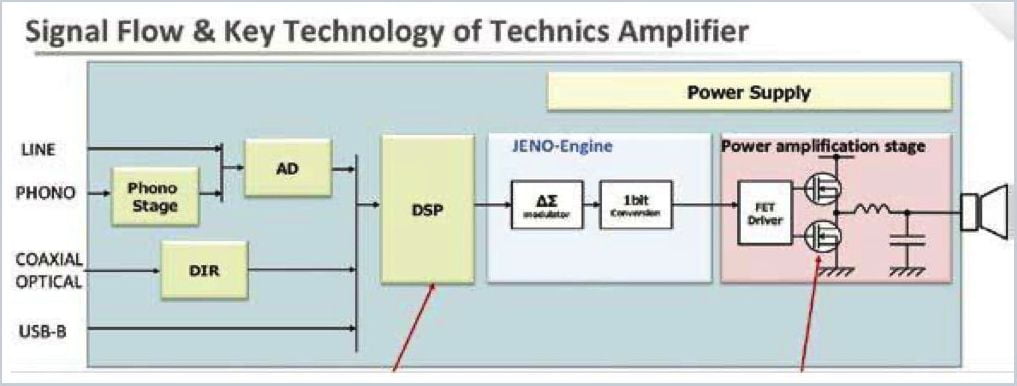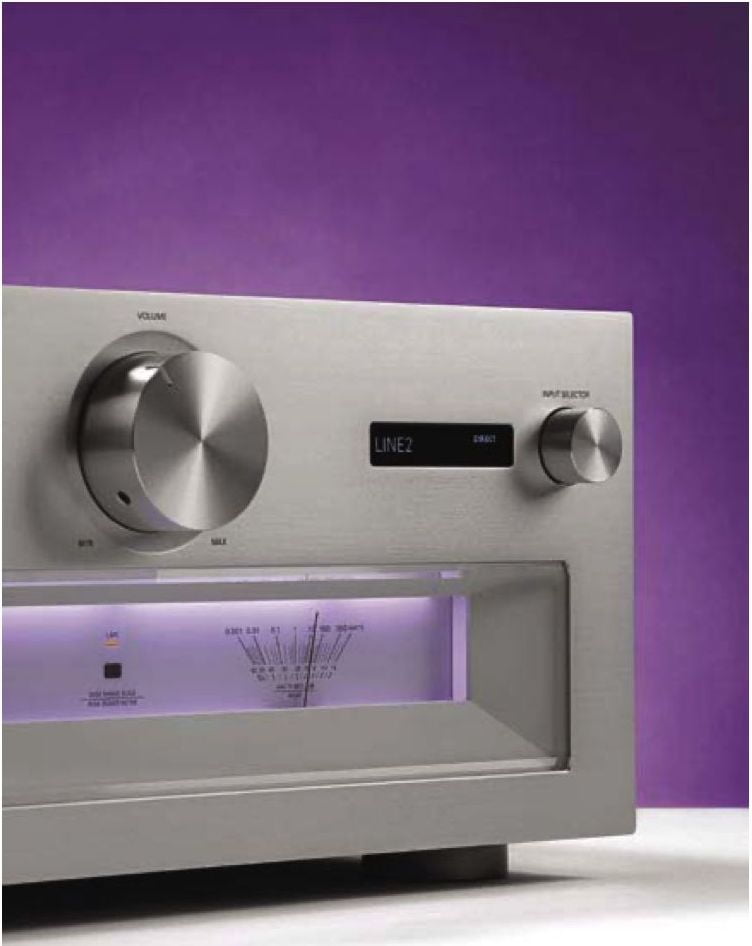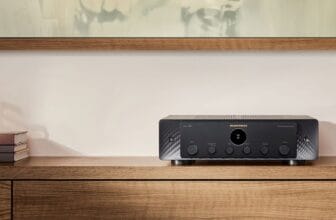Technics Reference SU-R1000 Review
Technics Reference SU-R1000 amplifier is digital but different. Noel Keywood explains. Read our Technics Reference SU-R1000 Review.
I have never before been faced by a test LP when unboxing an amplifier.The two inhabit different realms, so something was going on here. Technics new SU-R1000 Reference integrated amplifier, price £ lies at very top of the company’s product range, a technological statement that brings together modern digital – in conjunction with old LP tuned by computer using that test disc. Prepare for some technological surprises here, not all what you might expect.
At heart the SU-RI000 is an analogue switching amplifier but it is not Class D Technics tell us. The topology is similar however, as is performance (see Class Issues box-out).
It’s driven by a switch mode power supply. Power output is quoted as 150 Watts into 8 Ohms and 300 Watts into 4 Ohms, figures confirmed by our measurements. Modern Class Ds (Hypex, B&O) with a switch-mode power supply are compact and run cool, like Cambridge Audio’s Evo 150 I reviewed last month. In contrast Technics’ new reference amp is big, heavy and has large internal heatsinks that send warm air out through top vents, making the top panel get warm.
The front has clean lines and visually engaging illuminated power meters with I W centre scale and 300W maximum at right.There’s a small, orange LA PC light to show that the unit has been computer tuned – not left in raw untuned state.Above sits a motorised volume control that turns when remote control is used. There was a lovely smooth action and instant readout of volume level – 88dB up to OdB maximum came up on a small, blue dotmatrix screen alongside.
This also shows input selected, either by the rotary input selector knob or by remote control, plus Menu and Setup conditions. It has a lot to reveal and was curtailed with some of the longer messages. At left lies a power switch and headphone outlet; the loudspeakers (A/B) can be switched off for silent headphone listening.There’s 30V on the loudspeaker terminals, with no warning I could find in the User Manual – a major ommission. This problem was common in early Class D designs.
The barren simplicity of the front panel hides a lot of internal complexity.The SU-RI000 relies on being ‘digital’, meaning all analogue inputs are converted to PCM digital through a high quality AKMAK5574 ADC (their technical notes, littered with errors, says AKS5572 but there’s no such thing).This is a very high spec ADC.There is a PCM-to- one-bit convertor to drive the not-Class D power amplifier. Technics call this their Jeno engine. Once in PCM digital, frequency response manipulation is possible, giving rise to bass, middle and treble tone controls, a whole slew of historic equalisations for the Phono input and an unusual need to tune the power amplifier for flat frequency response through an LAPC (Linear Amplitude and Phase Correction) computer tuning scheme, because it’s load sensitive. This Technics say, compensates for external loudspeakers, but that’s only because they affect the amplifier’s output filters, making it load sensitive. Connected to standard resistive loads (4Q & 8Q) it did not measure flat with LAPC switched out, so it has to be tuned – unlike Class Ds from Hypex or B&O for example.This tuning applies only to the power amplifier, not to any preceding stages, so it does not affect either the Rec or Pre analogue outputs.
There are two standard analogue Line inputs through RCA phono sockets and one through balanced XLR sockets. An input ADC always imposes a low overload limit, in this case a satisfactory 3V that can be increased to 8V by using an attenuator in Menu, a handy feature.
The Phono stage for LP replay has RCA phono sockets switchable in Menu for MM or MC, plus a balanced XLR input that is MC only.With Phono selected the Menu comes up with Gain, Subsonic Filter, Equalisation curve and a Cartridge Optimiser function that brings into play that test
LP I was confronted with when unpacking.Yes, this amplifier can computer-tune the phono stage to compensate for the cartridge being used by running the enclosed test disc! It tunes not only frequency response but minimises crosstalk too, for up to three cartridges. For this to work the test disc must itself be of exemplary performance – very difficult to achieve. Other discs cannot be used since the amplifier’s computer works only with the unique gliding tone and white noise bursts cut into this one. I say more about this in The LP Optimiser box-out. Optimisation can be switched out if wished.There are no loading options for MM or ML cartridges: 47kQ and 100Q are used, the usual standards.
And finally there are a slew of equalisations in addition to RIAA (the common standard). Our review amplifier had IEC, Columbia, Decca FFRR.AES, NAB and RCA options. IEC is RIAA with a drastic warp filter that slashes bass below 100Hz, but there’s also a subsonic filter function that provides better behaviour – a sharper cut-off below 40Hz.The other curves are for old discs.
And now to digital.Technics fit two USB computer inputs (PC I & 2), plus two electrical digital S/PDIF inputs and two optical S/PDIF inputs.The USBs accept up to 768kHz sample rate PCM (up to 32bit) my MacBook Pro (and Audirvana+) declared and also DSD 256 (via DOP encoding). The digital stages had super low distortion and massive dynamic range under measurement. Quite how Technics have configured this amplifier internally I do not know, but the Record and Preamp outputs may come from a DAC, likely a top ARM.The loudspeaker output passes through PCM-one- bit conversion stage sitting in front of the not-Class D amplifier.
I mentioned earlier the SURI 000 runs warm; mains power consumption whilst idling measured 80 Watts. This rose to around 90 Watts with a few audio Watts being delivered from each channel, as in real-life use. An Auto-Off circuit exists to switch the amp off after inactivity and this, I found, will switch the amp off and lose all settings after LP optimisation if, like me, you walk away from a 10 minute calibration delay to buy a sandwich at the local supermarket! It can be switched out.
Best for two people to manipulate the Technics 22.6kg (501 bs) weight, when sliding onto a rack greater than its 430mm width, 191 mm height and 459mm depth. Since standard 19in racks are 482mm wide there’s plenty of leeway here.

SOUND QUALITY
Fed CD from our Oppo UDP- 205D player via a QED Quartz glass fibre digital link the SU-RI000 showed quickly that it has a fine sense of clarity and muscular deep bass, when driving our Martin Logan ESL-X hybrid electrostatic loudspeakers. Spinning a wide variety of high dynamic range (uncompressed) music tracks like Loreena McKennitt’s Gates of Istanbul rumbling deep bass lines bordered on vast, making me go back to check damping factor, because there was a sense of valve amplifier heft to bass, rather than the constrained quality that a high damping factor usually produces. But no, the Technics had good electrical damping but just seemed to deliver huge power, giving its sound weight and stature.
As the tracks slid by I was aware of a nice smoothness across the midband, that fluid quality that comes from a good DAC. I’m uncertain that with digital input and PCM-one-bit conversion the amplifier has a DAC in the main signal path (there is an ADC in the feedback loop) so perhaps I was hearing the purity of its processing, bearing in mind just a few Watts were being delivered the meters showed, running loud into a 17ft long lounge.
All the same, there was a discernible hue to the amplifier. When I wicked up volume to get I0 Watts or so on peaks – meaning loud – tracks containing a lot of high frequency information got hard and glassy.There was strident sheen to Willy DeVille singing Spanish Harlem for example. It imparted starkness of definition,


I could say – a complimentary subjective interpretation. If I raised volume even more the crack of ‘Class D’ distortion appeared and that’s when this interpretation went out of the window.The ESL- X XStat panel is a capacitor that falls to 3Q at 10kHz and this the Technics did not like, but since 4Q tweeters are now common, being able to cope with low/reactive loads is crucial – the amplifier’s Achilles Heel.
Spinning an even stiffer test, Nils Lofgren’s Keith Don’t Go, with vivid harmonics up to 20kHz from violently strummed metal guitar strings close-miked, I got a shock. As volume went up to very loud the glassy crackle of ‘Class D’ distortion became apparent – then the amplifier shut down. But no more than 20 Watts on occasional peaks was showing on the meters.
Oh! I’ve never experienced an amplifier shut-down with our ESL-X electrostatics, even though they are a mean load at high frequencies.Time to try again.And it happened again. A sudden clunk and silence.The protection circuits weren’t having any of this, which left me a bit non-plussed.
At listening levels of a few Watts the SU-RI000 had a fine sense of clarity and, with most material, smoothness. Its treble tone is not sweet, rather a tad dry and clinical.This gave the amplifier a ‘correct’ rather than romantic quality. Impressive in its own way, I understand that some may be impressed by it.When pushed hard though the SU-RI000 signalled enough and fell silent.
Wheeling in a pair of Sonus Faber LuminaV loudspeakers the SU-RI000 emphasised just how clean, clear and dynamic it is at normal listening levels (a few Watts on the meter). Again, I got the impression that the digital processing was imparting spectacular vocal clarity, making the Technics worthy of its Reference class moniker. But that was until I turned volume up and then, again, treble took on a hard quality, those vivid strings of Lofgren’s guitar again became strident.This time the protection circuits didn’t kick in – but I could only manage 10 Watts or so on peaks and remain listening, so the test wasn’t an especially severe one.
CLASS ISSUES

There are two issues to cover here. First is that Technics say this is not a Class D amplifier, even though it has similar topology. Second is Class D and how it compares.
The diagram in Technics technical notes for the SU-R1000 (below) shows an AD (Analogue-to-Digital) convertor in the pre-amp stages that is producing PCM (Pulse Code Modulation) digital that can be processed in the DSP (Digital Signal Processor), for gain adjustment. tone controls and Phono stage equalisations. The DSP feeds PCM into a Delta-Sigma modulator that produces one-bit – a stream of pulses. In Class D the pulses are Pulse Width Modulated (PWM) and that is the definition of Class D. I presume that Technics are using Pulse Density Modulation (PDM), otherwise known as DSD. also possible (but they don’t say).
Key points here are a low pass filter in the output to integrate the pulse stream and an ADC (AKM AK5574) that can output DSD in the feedback loop (not shown here). NAD’S M2 amplifier used similar techniques and was “not Class D” they said, using patented Zetex DDFA technology that Zetex labelled Class Z. Qualcomm also have DDFA amplifiers that again are “not Class D”. Technics are careful not to identify their topology.
However, all these amplifiers feed a pulse stream into a low pass output filter and the latter is loudspeaker sensitive, meaning the load affects the amplifier – as it does with the SU-R1000. Hence the need for LAPC tuning to achieve flat frequency response. So not Class D then, but similar topology with similar problems. The other classic problem with Class D is high frequency distortion and this the SU-R1000 suffered too.
However, new feedback techniques, as used by Hypex in their NCore module, have rendered Class D insensitive to loudspeaker load, also eliminating high frequency distortion our measurements show (see Cambridge Audio Evo 150 review. Sept 2021 issue). So Technics have entered a minefield here, full of patents and players all struggling to make a decent digital amplifier.
THE LP OPTIMISER
Tune up a cartridge using a special test LP and a computer? Intriguing. The test LP has four sets of tracks, two per side. Each track has a complete test sequence covering both channels.
Running this test with our Audio Technica OC9X SH moving coil (MC) cartridge no adjustment of phono stage equalisation occurred our spectrum analyser revealed.
Apparently, no useful result. But perhaps not. Modern cartridges like the OC9X do not need tuning: they’re flat in response. That the optimiser had no affect in our case was a good thing. It is for inaccurate cartridges only – uncommon nowadays.
CONCLUSION
Providing volume is kept in check Technics SU-RI000 Reference amplifier offers impressive sound quality: it has stark clarity, easy flow and thunderous bass. Making other amplifiers appear hazy, soft or mellifluous by way of contrast. But when volume was turned up treble distortion became obvious, then its protection circuits kicked in with our electrostatic loudspeakers. It’s unacceptably loudspeaker sensitive measurement with inductors showed and too problematical all round; other amplifiers do not need tuning to work properly. Add in the fact that there’s 30V on all output terminals and recommendation is difficult.

MEASURED PERFORMANCE
The SU-R1000 produced 180Watts into 8 Ohms and 340 Watts into 4 Ohms, so it meets its quoted 150 W spec, but into a resistive load only. Both loudspeaker terminals float 30V above ground, a classic Class D problem.
With purely resistive loads distortion levels at 1 kHz were low at 0.003% at 1W and 0.07% at high output into a 4o load. At 10kHz distortion levels were 0.02% at 1W and 0.08% near full output.
With wire-wound loads possessing small inductance (0.18mH) distortion levels rose 0.2% at IW/lkHz and 0.3% near full output (4Q). At 10kHz distortion levels jumped, measuring 0.3% at 1W and a massive 2% near full output, with extended odd-order harmonics. With 0.3mH distortion rose to a massive 10%. The SU-R1000 is load sensitive (LARC had no affect on these figures).
With purely resistive loads and no LAPC correction, frequency response of the power amplifier peaked by +2dB at 71kHz into 8 Ohms and fell by -3dB into 4 Ohms – a big change, explaining the need for LAPC that tuned response flat.
With the wire-wound loads frequency response of the power amplifier peaked by a massive +14dB at 96kHz, so LAPC must be used since the amplifier is very load sensitive.
Record and Preamp analogue outputs come before the power amp so are unaffected by this peaking or high frequency distortion. Their upper response limit (-IdB) was 43kHz.
The XLR and RCA phono socket analogue Line inputs were sensitive, both needing 180mV for full output, but with a strict overload ceiling of 2.7V due to the ADC. An attenuator can be switched in (Menu) to raise this limit.
The digital (S/PDIF) input had similar frequency response to the power amplifier. Distortion measured a very low 0.012% at -60dB (24bit) and EIAJ Dynamic Range (24bit) a high 123dB.
The USB (PCI) input accepted up to 768kHz PCM and DSD256, having a massive EIAJ dynamic range of 124dB. Distortion and frequency response were same as S/PDIF.
The Phono stage was sensitive, MM/MC needing 2mV/0.2mV for full output at OdB Gain, with satisfactory 28mV/3mV overload ceilings. There are +3/-3-6/-9dB Gain options, the lower ones raising the overload ceiling. Noise levels were low, just 0.13/tiV equivalent input noise (A wtd) for MC.
RIAA equalisation was accurate with both MM and MC, giving flat response across the audio band. Switching in Subsonic introduces fast cut below 40Hz to suppress LP warps.
Technics not-Class D power amplifier produces strong high frequency distortion into a reactive load, if not into a resistive load. Loudspeakers are reactive so a worrying sign. Frequency response is also load dependent, hence LAPC tuning. None of this is in line with performance from current analogue amplifiers or Class Ds from Hypex/B&O – unimpressive.
Power (8Q, 1% thd) 180W Frequency response (LAPC) 3Hz-100kHz

TECHNICS SU-R1000
GOOD – worth auditioning
VERDICT
Technics www.technics.co.uk






